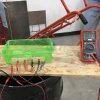Ali Kazemian
- Oct 12, 2015
- 8
- Joined
- Oct 12, 2015
- Messages
- 8
I'm trying to build a device which measures the electrical resistivity of a paste (cementitious materials) using Arduino. Four steel probes are put inside the paste (jumper wires attached to them). Two outer probes apply AC signals (Square signals- Frequency 1 kHz- Voltage(peak to peak)= 14 V) and two inner probes should measure the potential difference. Then the resistivity could be calculated by a formula. Schematic and sample pictures are attached.
I managed to apply the desired AC current, but the issue that I have is about reading the potential difference (two inner probes) by Arduino. When I used a multimeter (set to AC mode) I read some values (voltage) which should be correct, but using Arduino as the same time I read different values! I cannot see why!
I use analogue pin (A0) to read values, convert it to voltage ( float voltage = sensorValue * (5.0 / 1023.0); ) and print it to serial monitor. I programmed Arduino to read values 10 times during a second and report the maximum value only (although since symmetric square waves are applied, only direction of current should change, not the amount). There is not a linear relationship between values either (Examples: (Multimeter: 0.712 V, Arduino: 1.15 V)-(Multimeter: 0.68V, Arduino: 1.10V)-(Multimeter: 0.67V, Arduino: 1.03V)).
I would really appreciate any help from you guys!
I managed to apply the desired AC current, but the issue that I have is about reading the potential difference (two inner probes) by Arduino. When I used a multimeter (set to AC mode) I read some values (voltage) which should be correct, but using Arduino as the same time I read different values! I cannot see why!
I use analogue pin (A0) to read values, convert it to voltage ( float voltage = sensorValue * (5.0 / 1023.0); ) and print it to serial monitor. I programmed Arduino to read values 10 times during a second and report the maximum value only (although since symmetric square waves are applied, only direction of current should change, not the amount). There is not a linear relationship between values either (Examples: (Multimeter: 0.712 V, Arduino: 1.15 V)-(Multimeter: 0.68V, Arduino: 1.10V)-(Multimeter: 0.67V, Arduino: 1.03V)).
I would really appreciate any help from you guys!



